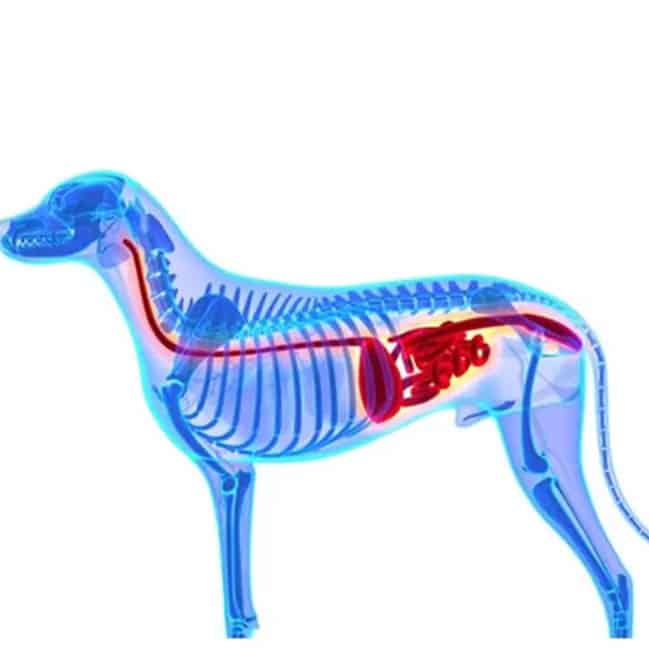Feeding the resilient brain: a smarter approach to canine anxiety
I came to study anxiety in dogs in a roundabout way. My whippet Oscar was diagnosed with epilepsy and as a result of his illness I ended up studying neuroscience and the effects of medication on the brain. Although I was interested in anti-seizure medications, the same mechanisms were apparent in anti-anxiety medications and these concepts have completely changed my view on canine anxiety.
Anxiety in dogs
Despite what we may believe, anxiety is not a malfunction. It’s a conserved biological response designed to help animals detect threats and survive. In modern life, even well-loved dogs are often expected to keep pace with human schedules, manage complex environments, and navigate daily life with little autonomy – conditions that can push their finely tuned stress systems into overdrive. The result for some? Chronic anxiety, difficulty adapting to change, emotional reactivity, and behavioural withdrawal.
For many vets, the default solution is medication. But long-term suppression of anxiety symptoms may come at a neurological cost. To understand why, we must explore how the brain regulates itself through homeostatic plasticity, and how suppression can backfire.
The brain’s balancing act: understanding homeostatic plasticity
To understand one theory of how anxiety develops, and why some interventions backfire, we need to introduce a few key players in brain communication: neurotransmitters. These are the brain’s chemical messengers, and they help regulate everything from movement to mood. In the context of anxiety, two particularly important neurotransmitters are GABA (gamma-aminobutyric acid), which calms the nervous system, and glutamate, which excites it. The brain constantly balances these signals to maintain emotional stability. When this balance is disrupted, by stress, diet, medication, or lack of recovery, anxiety can emerge as a byproduct of the brain trying to regulate itself.
The brain constantly works to maintain a stable firing rate across its neural circuits. This process, called homeostatic plasticity, allows neurons to adjust their excitability and receptor sensitivity in response to their environment. Homeostasis is like Goldilocks and her porridge, just enough [activity], not too much and not too little.
In 2008 a scientist called Turrigiano demonstrated that when neurons are silenced with drugs they don’t just shut down. Over time, they compensate by upregulating excitatory receptor expression. When the suppression is removed (in a washout), these neurons exhibit rebound hyperactivity, firing even more than they did before.
In plain English, the system overshoots in its attempt to recalibrate. It’s like when you’re convinced your dog just hasn’t heard you in the woods, so you shout again (when in fact they’ve probably just found a squirrel).
This has enormous relevance for anxiety (and epilepsy alike) because it seems when we suppress the nervous system long-term, the brain doesn’t just accept it, it fights back.
In dogs, this means that chronic exposure to medication (i.e. GABA-enhancing substances, such as benzodiazepines, valerian, or synthetic GABA analogues), may lead to a reduction in GABA receptor sensitivity. In response, the brain ramps up its excitatory systems, particularly glutamate and noradrenaline, to restore balance. Once the suppressive influence is removed, or simply loses effect, the nervous system may rebound with increased excitability, showing up as worsened anxiety or reactivity (or threshold seizures).
These interventions suppress symptoms temporarily, but they don’t resolve the underlying dysregulation, and may ultimately leave the brain more fragile, not less.
Anxiety as a failure of regulation, not a lack of calm
Anxiety is not a character flaw or a behaviour problem. It is a sign that the brain’s self-regulatory systems are under pressure. These systems include the balance between excitatory and inhibitory neurotransmitters, such as glutamate and GABA; the HPA axis, which governs cortisol release and the stress response; mitochondrial function, which fuels the brain’s energy-intensive processes; and the gut-brain axis, which contributes to mood and reactivity through microbiota, immune signals, and nutrient availability.
When these systems are stressed – by poor nutrition, inflammation, lack of control, or chronic overstimulation – anxiety emerges not as a root issue, but as a downstream symptom. Suppressing the symptom without rebuilding the foundation may quieten things temporarily, but it leaves the dog reliant on suppression, with greater risk of rebound reactivity.
This is where we must shift from control to support, from silencing symptoms to equipping the nervous system with the resources it needs to self-regulate and we do this through building resilience.
Adaptive nudges: building the resilient brain
Supporting resilience means working with the brain, not against it. One of the most overlooked tools we have is nutrition. The brain is metabolically demanding. Every thought, emotional response, and regulatory process depends on a constant supply of fuel, micronutrients, and biochemical balance. When those needs are met, the brain becomes more stable, less reactive, and more adaptable.
Magnesium helps modulate excitatory receptors and calm overactivity. B vitamins such as B6, B12, and folate are essential for producing GABA and serotonin, neurotransmitters that support emotional regulation. Omega-3 fatty acids, especially EPA and DHA, reduce inflammation in the brain and support the health and function of neuronal membranes. Nutrients like taurine and zinc help modulate neurotransmitter systems and protect the brain from oxidative stress. Medium-chain triglyceride (MCT) oil provides ketones, an alternative brain fuel that improves mitochondrial function. For dogs, these brain-supportive nutrients can be found in foods like oily fish (rich in omega-3s), organ meats (high in B vitamins, zinc, and taurine) and MCT oil (which provide ketones for brain energy).
Novelty to build resilience
Resilience is also built through experience. When dogs encounter new environments, smells, textures, or problem-solving tasks in a safe and supported way, they activate brain regions involved in dopamine release, learning, and adaptation. Mild novelty teaches the nervous system that change isn’t dangerous, it’s manageable. With repeated positive exposures, the brain develops more flexible pathways and improved capacity to recover from stress.
Don’t avoid all stress: use it wisely
Although it’s tempting to protect anxious dogs from all challenges, avoiding stress entirely may do more harm than good. The brain builds strength through tolerable stress followed by recovery. This concept, known in neuroscience as stress inoculation, shows that animals exposed to manageable adversity early in life develop stronger coping systems.
Dogs benefit from small frustrations, low-stakes uncertainty, and problem-solving tasks, as long as they are supported and allowed to succeed.
This approach mirrors what we’ve long understood from human research. In a landmark longitudinal study, Emmy Werner followed children born into high-risk environments over four decades. She found that those who grew into well-adjusted adults despite early adversity all shared key protective factors: a secure, stable relationship with a caregiver, meaningful engagement in activities, and opportunities to develop autonomy and competence through supported challenge. These findings translate directly to dogs. When dogs feel safe with their person, are given appropriate outlets for natural behaviours, and are allowed to face and recover from manageable challenges, they develop resilience. Just as in humans, resilience in dogs isn’t about avoiding stress altogether, it’s about equipping the nervous system to recover from it.
Physical activity: a neurobiological tool for resilience
Physical activity is also one of the most effective tools for regulating the brain. Movement increases the availability of neurotransmitters like serotonin, dopamine, and GABA. At the same time, it helps clear excess glutamate, an excitatory neurotransmitter that is often elevated in anxious states. Exercise also reduces baseline cortisol levels, supports more effective stress recovery, and improves sleep regulation by stabilising the body’s circadian rhythm.
Beyond these chemical effects, movement stimulates the release of brain-derived neurotrophic factor (BDNF), a protein that supports the growth and repair of neurons and strengthens the brain’s ability to adapt. But even more importantly for dogs, physical activity provides fulfilment. Allowing dogs to sniff, explore, and choose their own direction satisfies their biological needs and activates deep reward pathways in the brain.
Resilient dogs aren’t calm, they’re capable
Anxiety in dogs isn’t a behavioural flaw; it’s the visible output of a nervous system under pressure. Suppressing that output might offer temporary relief, but it can push the brain further from balance. Rebound effects, reduced self-regulation, and long-term fragility are the neurological cost.
Instead, we can build resilience. With nutrient-rich food, meaningful movement, safe novelty, and supportive challenge, we help the brain regain control, on its own terms. Resilient dogs aren’t free from stress; they’re just better at recovering from it.
Lisa Hannaby-Aird
Lisa is a psychologist, registered associate nutritionist, integrative sports nutritionist, published author of Nutrition for Dogs, researcher and educator. Most recently, Lisa has started studying MSc Applied Neuroscience at Kings College, London. Lisa works with both humans and canines on nutrition (general, sports and performance), behaviour and overall well-being. She is owned by a GSD, Akita, two whippets and two cats. Lisa is an avid mantrailer and canicrosser.
References
- Turrigiano, G. (2008). The self-tuning neuron: synaptic scaling of excitatory synapses. Cell, 135(3), 422–435.
- Werner, E. E. (1993). Risk, resilience, and recovery: Perspectives from the Kauai Longitudinal Study. Development and Psychopathology, 5(4), 503–515.
- Salmon, P. (2001). Effects of physical exercise on anxiety, depression, and sensitivity to stress. Clinical Psychology Review, 21(1), 33–61.
- Cotman, C. W., & Berchtold, N. C. (2002). Exercise: a behavioural intervention to enhance brain health and plasticity. Trends in Neurosciences, 25(6), 295–301.
- Berk, M., et al. (2013). So, depression is an inflammatory disease, but where does the inflammation come from? BMC Medicine, 11, 200.



